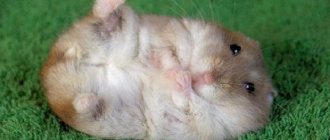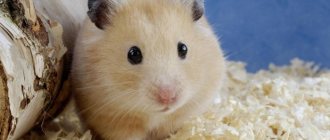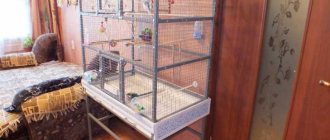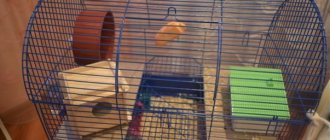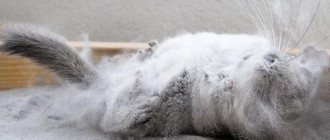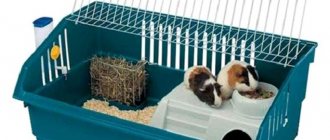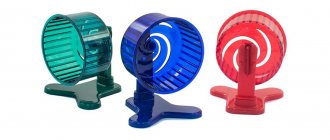Hamsters in the house need to create the right conditions for existence, because the health of the pet and its lifespan depend on this. The first step is to choose a good cage where he will feel cozy and comfortable. When choosing this accessory, the size and breed of the hamster are taken into account.
In the article we will look at the types of cages for Djungarian and Syrian hamsters, what they can be made of, the minimum size, what design is best to choose, what should be in a hamster’s cage and where to put it.
Cage sizes for a Djungarian hamster: standards and norms
Individuals of the Djungarian breed are characterized by increased playfulness, activity, and restlessness, so they need a spacious and free cage. The optimal area for one hamster according to standards is 1500 sq.cm. The corresponding cage dimensions are 50x30 cm.
Other requirements for a “hamster” house:
- height not less than 30 cm;
- the maximum distance between the rods is 1 cm;
- pallet - 35x55 cm.
In cramped cages, Djungarian hamsters rapidly gain weight. Due to a lack of physical activity, they develop obesity. The animal looks apathetic and sleepy. Health problems begin and life expectancy decreases.
Therefore, it is extremely important that the cage allows the dwarf to move freely.
Where and how much can you buy a hamster house?
Answering the question of how much a hamster cage costs in a pet store, below are the prices for the houses.
The Cats and Dogs pet supply store sells cages that cost from 2 to 10 thousand rubles. The price of the Ferplast Laura cage is 4038 rubles. The set includes a plastic wheel, drinking bowl, nest and transparent tunnels. The product is easy to clean thanks to the removable tray.
The Savic Hamster Metro cage is a spacious play complex for a hamster; it will cost 9 thousand rubles. This accessory is made of durable food-grade plastic. This house is equipped with slides, feeders, drinking bowls, a long play tunnel and even a toilet.
What should be in a hamster's cage?
In the Lemurrr chain of pet stores you can find cages that cost from 1 to 5 thousand rubles. The price of the model depends on the size and number of additional elements .
The Petshop online store offers cages from manufacturers Benelux and Yami-Yami. The cost of products varies from 1,700 to 5,000 rubles.
Next, we will answer the questions about what exactly a cage for a hamster should be and which one is better to choose.
Single-story or multi-story: what to choose?
The classic option is a one-story metal cage. It is easy to disassemble, convenient and quick to clean. This design can be additionally equipped with a tunnel or pen: the dwarf will have more room to run.
The second option is a cage of several floors. For such a house there are a number of additional requirements.
Cparks/Pixabay
The distance between floors is from 17 to 25 cm. If the height is more than 30 cm, the level of injury risk increases.
The floor should be solid plastic, since food, bedding and the rodent’s paws will fall through the grate when running. Please note that the cages have height-adjustable tiers.
So which option is better? It is recommended that Djungarian hamsters choose single-story cages with a large area. Individuals love jogging and free space. This is much more interesting for them than climbing or climbing up bars.
Requirements
The main criteria when choosing a cage are its comfort and safety for your pet. In addition, the future home of a furry friend should be comfortable for its owner. The owner needs to select in advance the place where the new home will be located, and also select a product for a certain size, no less than the minimum recommended for a dzhungarik.
The materials from which the cage is made must not only be durable and strong, but also safe. Rodents taste everything they see, so the grill bars they try should not be harmful to the health of the animal.
Choose a cage that is easier to clean. It is more convenient to buy a product with a pallet. Be sure to check that the door closes well.
Djungarians are very curious creatures, prone to escape, and a weak locking device may not withstand its sharp teeth. Try to buy a home with built-in attributes in advance. This will be a more economical option, and in the future you won’t have to think about where and how best to install all the additional devices.
Materials
Pet stores offer several options for hamster cages.
- Made of metal rods. A good ventilated home in which the rodent feels quite comfortable. The inconvenience is that the noise the hamster makes can be clearly heard through the bars, and dirt always forms around. Filler and debris easily penetrate through the bars. The grill itself should be made of high-quality solid metal.
Do not take products made of copper or aluminum - the animal gnaws everything, so it will quickly render such rods unusable.
- Plastic or glass aquarium. In such a closed home, the noise level is significantly reduced, and there is almost no garbage. In addition, this is the safest option for a home where there are cats - it is unlikely that a predator will get to the rodent, which is kept in an aquarium under a breathable mesh. However, the hamster himself will be uncomfortable in such a home, since it does not allow air to pass through well.
The inconvenience for the owner is that the aquarium is difficult to clean.
- Lattice cage with plastic tray. This is the most preferred option. This cage is easy to clean. If the home is two-level, and the “floor” of the second floor is made in the form of a lattice, then check whether the pet is injured by getting its paws or abdomen stuck between the bars. If the risk of injury is high, cover the second level with cardboard.
The right pallet: what is it?
This is a structural element, a kind of “latrine pit” of the cell. Garbage and crumbs are poured here, and waste flows out. There are several types of pallets.
The division occurs on the basis of the mechanism of action (retractable), material of manufacture, size.
Housing for a Djungarian hamster must be equipped with a deep tray. During their games, individuals scatter the filler, and the high walls of the tray will not allow debris to fly out of the cage.
Pros and cons of breeding dzhungarikas
Breeding Djungarian hamsters is not that profitable. The retail price of a young individual rarely exceeds 200 rubles, and breeders sell rodents to stores in bulk for a lower price. It turns out that the owner gets about 100 rubles from each hamster, and 500-600 rubles from one litter. At the same time, he spends much more on the maintenance and care of his pets - he invests money in cages, food, supplies, and veterinary care.
There are other difficulties in breeding dzhungariks. During breeding, the female and her children need complete rest. It is quite difficult to provide this if the rodents were purchased for children.
Another problem that Djungarian hamster breeders face is finding a new home for their growing rodents. A lot of babies are born, so it can be very difficult to place them in good hands.
Breeding Djungarian hamsters at home also brings little benefit. Females live much longer when they do not waste their body’s energy and resources on bearing offspring and giving birth. Animals do not suffer at all from not reproducing.
Obviously, the reproduction of Djungarian hamsters is a fascinating process. But it requires a lot of time, effort and material costs from the rodent owner.
How to make a cage for a dwarf with your own hands
First you need to choose the material. Only non-toxic and durable elements are allowed to be used. A house for the animal can be built from unpainted boards or plywood, plastic, coconut shells and even thick cardboard. It is important to remember that homemade cages made from natural elements are short-lived, since the hamster will constantly sharpen their upholstery and walls with his teeth.
How to make a reliable and safe cage: step by step processes.
The chosen material is plywood and boards. You will also need a metal mesh and plexiglass.
The necessary tools are a marker or felt-tip pen for markings, hot-melt adhesive and hot-melt gun, and a cutter.
We cut and sand 3 boards of the same size.
We drill a 5-6 cm hole in one of the boards.
We connect the resulting elements together. Coat it well with glue, keep it pressed tightly for 3-5 minutes.
We attach a metal mesh to the resulting sides from above.
Cover the remaining side with plexiglass (with hot-melt adhesive).
The fastening of parts and mesh is done strictly from the outside so that the dzhungarik does not get hurt on the protruding edges.
The design features of such a cage will allow you to freely observe your pet, and the mesh will provide a constant flow of fresh air.
Where is the best place to put a hamster cage?
A person’s apartment or house is a noisy and stressful place for such a miniature animal as a hamster. To limit the animal from constant stress, the cage must be placed in a suitable place.
It should be a quiet, secluded corner, protected from drafts, open sun and loud sounds. Exposure to ultraviolet radiation or wind will negatively affect the hamster’s condition (colds, overheating).
Memo for owners of Djungarian hamsters
- The furry's home should be at a distance from the music center, TV and other noisy devices.
- Temperature stability. Suitable indicators are 18-21C. When the mark drops below 10 degrees, individuals hibernate.
- Protection from cats. Djungarians are an easy target for mustachioed pets; cages should be placed out of their reach.
How to set up a cage for a Djungarian hamster
The spacious cage can accommodate additional attributes. Some of them are mandatory, others are installed at the request of the owners.
Similar products are available in any pet store, some of them are easy to make with your own hands.
An important attribute for the comfortable existence of Djungarian hamsters is bedding. This is the substrate with which the bottom is covered. You cannot take cotton wool, bandages and other materials consisting of threads for these purposes (so that the animals do not get entangled in them).
Sawdust from pine and cedar is also prohibited, as they are sources of the development of respiratory diseases in rodents.
The traditional option is sawdust from deciduous trees. Layer - at least 6 cm. An alternative is to buy ready-made litter. These are special fillers, silica gels, granular mixtures.
Other necessary “interior” elements for dzhungariks
A house is a secluded place in which the animal will store its supplies and sleep. Mandatory elements are a wide entrance and a strong roof.
Feeder - small size, spacious, sides 1-1.5 cm.
Drinking bowl - it is better to buy special products, since the hamster will turn over ordinary bowls/lids. The optimal solution is a nipple drinker attached to the outside of the cage.
A running wheel is a necessary element for the dwarf to get daily exercise, stretch his paws and train his cardiovascular system.
Requirements:
- diameter – not less than 20 cm;
- non-slippery surface;
- fastening to rods.
- Wheels with crossbars and mesh are prohibited.
Mineral salt stone - needed for natural needs (grinding teeth), it will also enrich the animal’s body with useful microelements.
Important points
Cages for dwarfs must be well ventilated, otherwise the toxic odor of ammonia will accumulate in them. It is important that the home is comfortable, and that you can clean your pet at any time without spending a lot of time.
Cage for dzhungarika with proper ventilation
You can choose a plastic cage for your Djungarian hamster. Such models have several levels, tunnels, pipes and other places for games. They feature an original design.
The plastic home should not have protruding parts that the baby can chew.
Important: make sure that the doors close tightly - jungarians are smart and they will quickly understand the principle of opening doors, which may lead to repeated attempts to escape.
Remember that the best cage is one in which your pet is comfortable. You will see this in his behavior.
join the discussion
Share with your friends
The Djungarian hamster is an interesting and funny animal that can often be found in apartments as a pet. It is believed that these animals do not live long, but their lifespan depends on the conditions of their detention. The main factor in ensuring a full and comfortable life for your furry pet is purchasing a quality cage.
How often should the cage be washed?
Regular cleaning guarantees a healthy atmosphere inside the cage and the absence of extraneous unpleasant odors. Contaminated litter in the tray is cleaned daily.
The time for “general” cleaning is once every 2 weeks. Major cleaning consists of successive stages.
- Place the dwarf in a temporary home.
- Discard all filler from the tray. Leave a small handful of the contents so that the hamster's smell does not disappear.
- Throw away rotten food from your hamster's supplies. It is impossible to clean out the entire “pantry”, since the loss of savings will result in severe stress for the dzhungarik.
- Wash the tray with warm water. Use baby soap and animal shampoos as detergent. Do not use cleaning products with an aggressive composition (white, powder).
- Use a sponge soaked in soapy water to treat the rods. Wipe all attributes and accessories with a dry cloth.
- Wait until completely dry. Pour in new filler and mix it with a handful of old.
- Letting the dwarf into his clean home.
USEFUL TIPS ON HEALTHY NUTRITION
All products that you give to the animal must be fresh. Avoid frozen vegetables and fruits. They no longer contain useful substances. Observe the hamster's behavior. He can hide the fresh fruit and eat it when it is no longer fresh.
It is recommended to feed your pet twice a day, preferably in the morning and evening, at the same time. The regime is the key to good digestion of the animal. Monitor your pet's condition carefully. Is your hamster gaining weight quickly? Reduce your daily dose of food: overfeeding is harmful, as is undernutrition.
It is recommended to give juicier foods in the morning, and solid foods in the evening. Some experts recommend feeding the rodent 4-5 times a day, giving only as much food as it will eat at one time. If this is not possible, then collect leftover food from the cage every evening.
Hamsters have a habit of storing food for a rainy day. Firstly, food quickly spoils, and secondly, an unpleasant odor appears, food mixes with excrement, and becomes unsuitable for life. Stale food is dangerous for rodents.
Video: eating
Pregnant individuals
A pregnant pet should eat at least three times a day. The portion is doubled. Hay, nuts, and legumes are especially beneficial for pregnant rodents. Place hay directly into the feeder in small portions so that it does not mix with sawdust.
